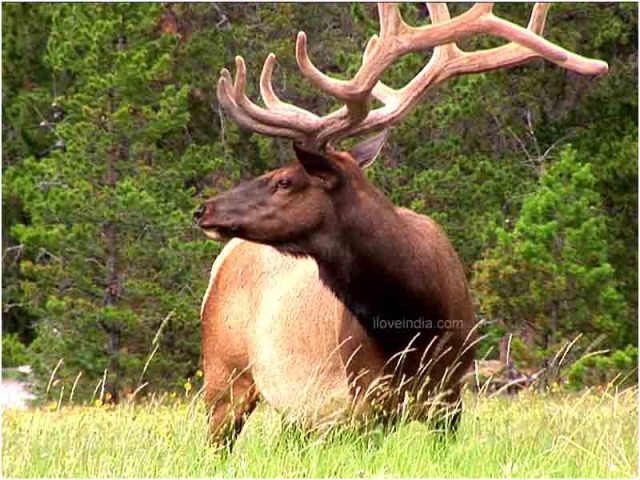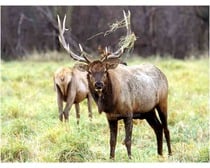The most outstanding fact about elk is that it is the largest species of deer in the world. Read on to know some more interesting facts and amazing information on elks.
Facts About Elk
Elk, also called wapiti, is the largest species of deer, which is found primarily in North America and East Asia. It is also one of the largest mammals inhabiting these regions. It has also been introduced to countries like New Zealand and Argentina. Elk resembles the red deer of Europe, though it has been established that both belong to different species. It is an herbivore animal and feeds on grass, shrubs, leaves and tree bark. Male elk is called bull, whereas the female is known as cow. The body color of an elk varies from deep copper brown to light tan. Its legs and neck are often darker than its body color. We bring you some more interesting facts and amazing information on elks, in the lines below.

Facts About Elk
Bionomial Name: Cervus candensis
Kingdom: Animalia
Phylum: Chordata
Class: Mammalia
Order: Artiodactyla
Suborder: Ruminantia
Family: Cervidae
Subfamily: Cervinae
Genus: Cervus
Species: C. Canadensis
Size: Height at the shoulder, 1.2-1.5m
Weight: 325-1,100 lbs
Life Span: 10-13 years in the wild; 20 years or more in captivity
Diet: Herbivore
Call: Bugling
Habitat: Rocks, caves, bushes and almost anywhere in Australia
Mating: August - early winter
Gestation Period: 240-262 days
Number of Offspring: One
Interesting & Amazing Information On Elks
- Only the male elk has antlers on its head. The antlers are large in size and reach a length of 4 feet. On a mature elk, a pair of antlers weighs up to 40 pounds.
- An elk sheds its antler annually and this is mostly done in the month of March. However, the antlers begin to grow again, in the month of May, so they are fully grown by the late-summer breeding season.
- The new antlers are enveloped in a skin called velvet, which peels off as the antlers grow.
- In the early summer, the male elk proceeds to the high mountains, to graze, whereas the female elk reproduces.
- When an elk receives a signal of danger, it raises its head high and opens its eyes widely. It rotates the ears and tries to capture the sound.
- Elks threaten each other in a distinct style. They curl up their upper lip and grind their teeth, followed by a soft hissing sound. An agitated elk often uses its front hooves to punch the rival side.
- A male elk i.e. bull assembles the cows and calves in small groups, called harems. A bull is extraordinarily protective of its harem and can fight to any extent with another bull, for safeguarding its harem.
- For most part of the year, the adult elks remain in the group of same sex.
- The mating period of elk is known as rut. During rut, the bulls compete against each other to get the attention of the cows.
- During the mating period, a bull digs holes in the ground and urinates into it. Then it rolls itself in the hole, so that the urine gets into its hair. This gives it a distinct smell, which helps attract the cows.
- At the time of reproduction, the female elk i.e. cow tends to isolate itself from the herd. It remains alone with its calf, till the latter is large enough to escape the predators.
- At the time of birth, elk calves have spots throughout their body, which disappear as they grow.
- An elk grazes and browses primarily during the morning and evening and takes regular intervals to digest the food. It can eat up to 9.1 kg of various types of food daily.
- Chronic wasting disease is the most common disease found in elks. When affected by this disease, they begin to lose weight and face problems like disorientation, listlessness and an increased need for water.
- Elks are farmed for their meat, velvet and antler. Several artwork and furniture work can be made out of their antlers.
- Even the hides of elk have been used for a long period, for making tepee covering, footwear, blankets and clothes.


See also
More from iloveindia.com
- Home Remedies | Ayurveda | Vastu | Yoga | Feng Shui | Tattoos | Fitness | Garden | Nutrition | Parenting | Bikes | Cars | Baby Care | Indian Weddings | Festivals | Party ideas | Horoscope 2015 | Pets | Finance | Figures of Speech | Hotels in India : Delhi | Hyderabad | Chennai | Mumbai | Kolkata | Bangalore | Ahmedabad | Jaipur
- Contact Us Careers Disclaimer Privacy Policy Advertise With Us Lifestyle Sitemap Copyright iloveindia.com. All Rights Reserved.




